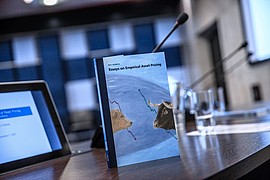PhD Defence: Roy Verbeek

In his dissertation ‘Essays on Empirical Asset Pricing’ ERIM’s Roy Verbeek investigates whether common risk factors are priced across investment horizons, estimates costs of equity capital for individual firms and industries using five models, and show that firms differ greatly in the extent to which their stock prices are driven by cash flow news versus discount rate news.
Roy defended his dissertation in the Senate Hall at Erasmus University Rotterdam on Thursday, 7 December 2017 at 13:30. His supervisor was Prof. Mathijs van Dijk and his co-supervisors was Dr Marta Szymanowska. Other members of the Doctoral Committee are Dr Mathijs Cosemans (RSM), Prof. Bruno Gerard (BI), and Prof. Dick van Dijk(ESE).
About Roy Verbeek

Roy Verbeek was born on February 23, 1990 in Tiel, The Netherlands. He received his BSc degree in International Business Administration (cum laude) in 2011, his MSc degree in Finance and Investments (cum laude) in 2012, and his MPhil degree in Business Research with a specialisation in Finance (cum laude) in 2013. All degrees are from Rotterdam School of Management, Erasmus University.
In September 2013, Roy joined the Department of Finance at Rotterdam School of Management as a PhD candidate. His PhD research was supported by a Research Talent grant from The Netherlands Organisation for Scientific Research (NWO) and supervised by Mathijs van Dijk and Marta Szymanowska. In the fall of 2016, he spent three months at BI Norwegian Business School in Oslo, Norway, as a visiting PhD candidate. Roy taught workshops for the BSc course Corporate Finance and supervised BSc and MSc theses.
Starting from September 2017, Roy will be working as an Assistant Professor of Finance at Nyenrode Business University in Breukelen, The Netherlands.
Thesis Abstract

This dissertation consists of three essays on empirical asset pricing. In the first essay, I investigate whether common risk factors are priced across investment horizons. I show that only the market and size factors are priced, but only up to sixteen months. The results highlight the importance of horizon effects in the pricing of systematic risk. They also raise concerns about the ability of asset pricing models to price individual stocks. In the second essay, I estimate costs of equity capital for individual firms and industries using five models. I show that there is considerable disagreement about costs of equity capital across the models and that they are estimated with great errors. The models exhibit some forecasting power for future returns only when the estimation errors are small. My results raise questions about whether popular asset pricing models can be used for computing costs of equity capital. In the third essay, I show that firms differ greatly in the extent to which their stock prices are driven by cash flow news versus discount rate news. The differences in their relative importance are associated with differences in firm characteristics, risk exposures, and expected returns. I also show that the amount of return co-movement and the success of variables that predict the equity premium depend on the relative importance of the two components.
Photos: Chris Gorzeman / Capital Images


